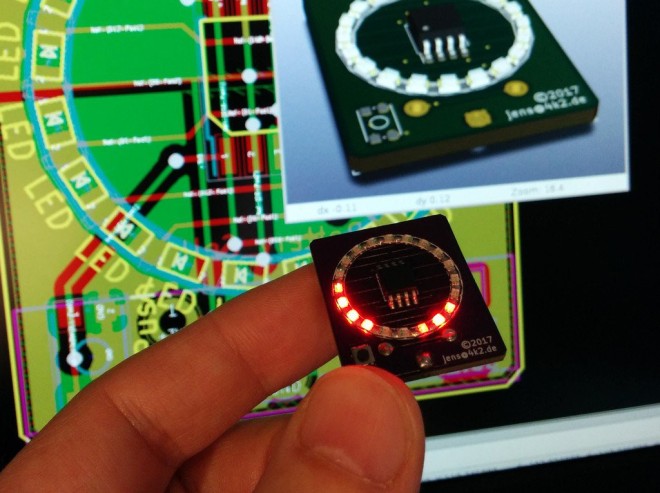
We were amazed to see the incredible wearable project by Zach from NeuroTinker while at CrowdSupply Teardown:
Cyborg Ring
Cordwood-style blinky ring, powered by an ATtiny85 and a pair of size 10 Zn-air hearing aide batteries.

We were amazed to see the incredible wearable project by Zach from NeuroTinker while at CrowdSupply Teardown:
Cordwood-style blinky ring, powered by an ATtiny85 and a pair of size 10 Zn-air hearing aide batteries.
tl;dr It’s a foundation for a wearable platform. It’s a Nato watch strap threaded through a PCB with a coin cell battery holder between the PCB and the strap. I’m using a Attiny85 this time around but could be used for most chips/dev boards. This is a proof of concept to iron out any problems […]
via Attiny wearable — Facelesstech
Jens Hauke designed this charlieplexed 20 LED blinker controlled by an ATTiny45 for the Hackaday Coin Cell Challenge:

This is a small blinky with 20 LEDs powered by one CR2032 coin cell
and with an ATTiny45 brain. The firmware is written in plain C and
compiled with the avr-gcc toolchain. The PCB is a two layer design made
with KiCad.
Space efficient daisychained LED placing with shared anode/cathode soldering pads.
Firmware and gerbers are available on GitHub:
Jens has shared the board on OSH Park:
Here is a video of the LED in action:
This Saturday, September 2nd, we will have one day workshop for assembling the Tinusaur kits for those who supported our Indiegogo crowdfunding campaign. It will take place in Varna, Bulgaria, our host will be VarnaLab – the local hackerspace. We will learn the basics of electronic components, microcontrollers – ATtiny85 in particular and, of course, […]
via Workshop: Assembling the Tinusaur Kit in Varna, Bulgaria — The Tinusaur Project
[dombeef] originally built pocketTETRIS as a Father’s Day gift for his Tetris-loving pops. However, having finished the project he’s decided to share it with the universe, and it’s looking rather sweet. He made the game the smallest he could make, with size limitations imposed by a 0.96” OLED display, the coin-cell battery pack, and his desire…
From Sven Gregori on Hackaday.io:
the USB MIDI keyboard dedicated to play all the four chord songs, from Adele via Green Day and Red Hot Chilli Peppers to U2 and Weezer. Thanks to MIDI, you can be any instrument – and all of them at once. Yay!
Built around an AVR ATmega328 and Objective Development’s V-USB library, 4chord MIDI acts as a regular USB MIDI instrument. It supports playback in every key and five different playback modes:
- simple triad chord (root, third, fifth)
- triad chord + third + fifth + third as quarter notes
- triad chord + third + fifth + octave as quarter notes
- root note + third + fifth + third as quarter notes
- root note + third + fifth + octave as quarter notes
The playback tempo can be set between 60 and 240 bpm.
Here is the board in action:
The design files and source code are available on GitHub:
The ATXMega32E5 is the next step up for those experienced with the AVR series of microcontrollers from Microchip (formerly Atmel). They use the same compilers and libraries as the rest of the AVR 8- and 16-bit families, but they can run at 32 MHz and have an amazingly powerful set of internal peripherals that can take your projects to the next level and beyond.
For prototyping, however, the disadvantage is that the XMega chips are not available as through-hole parts. That’s where this breakout board comes into play.
nsayer has shared the board on OSH Park:
Ken Olsen writes in a Surface Mount Challenge project log on Hackaday.io:
A majority of my projects to date have used DIP package Attiny85, 84, and Atmega328. These are usually programmed beforehand using a ISP shield on an Arduino, or afterwards using the ISP header. My first PCB design, was in fact, a shield which could be used to program the variety of AVR chips I was using. Breadboarding up an Arduino-as-ISP circuit time every time I needed one was error-prone and frustrating.
It occurred to me that since not all projects have ISP headers, there should be some way to program the chips prior to installation. With a little googling, I found SOIC to DIP adapters which can be used to mate up with a DIP ZIF fixture. A SOIC 20 allows me to program the AVR 8-pin, 14-pin, and 20-pin packages!

From the Rebooting Electronics blog by Steve Mayze:
In the last entry for the Timed LED Lighting Controller, I realised that there are no working examples of an I²C driver for the ATtiny20. I then had to work through the data sheet to implement my own. With that done, I could then start on the application firmware and get the board really working. So this is where my proof of concept becomes the prototype.
Hackaday wrote about a nifty hack by Joe Grand:
It’s not too exciting that [Joe Grand] has a toothbrush that plays music inside your head. That’s actually a trick that the manufacturer pulled off. It’s that [Joe] gave his toothbrush an SD card slot for music that doesn’t suck. The victim donor hardware for this project is a toothbrush meant for kids called Tooth Tunes.…
Joe published full documentation for the project on his website:
The PCB is shared on OSH Park:
Joe describes the project in this video:
Hear the toothbrush in action: